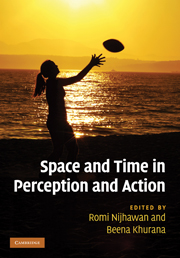Book contents
- Frontmatter
- Contents
- List of contributors
- Acknowledgments
- 1 Space and time: the fabric of thought and reality
- Part I Time–space during action: perisaccadic mislocalization and reaching
- Part II Temporal phenomena: perception
- Part III Temporal phenomena: binding and asynchrony
- 13 Dynamics of visual feature binding
- 14 How does the timing of neural signals map onto the timing of perception?
- 15 Mechanisms of simultaneity constancy
- 16 Relative timing and perceptual asynchrony
- 17 The time marker account of cross-channel temporal judgments
- 18 Simultaneity versus asynchrony of visual motion and luminance changes
- Part IV Spatial phenomena: forward shift effects
- Part V Space–time and awareness
- Index
- References
15 - Mechanisms of simultaneity constancy
from Part III - Temporal phenomena: binding and asynchrony
Published online by Cambridge University Press: 05 October 2010
- Frontmatter
- Contents
- List of contributors
- Acknowledgments
- 1 Space and time: the fabric of thought and reality
- Part I Time–space during action: perisaccadic mislocalization and reaching
- Part II Temporal phenomena: perception
- Part III Temporal phenomena: binding and asynchrony
- 13 Dynamics of visual feature binding
- 14 How does the timing of neural signals map onto the timing of perception?
- 15 Mechanisms of simultaneity constancy
- 16 Relative timing and perceptual asynchrony
- 17 The time marker account of cross-channel temporal judgments
- 18 Simultaneity versus asynchrony of visual motion and luminance changes
- Part IV Spatial phenomena: forward shift effects
- Part V Space–time and awareness
- Index
- References
Summary
Summary
There is a delay before sensory information arising from a given event reaches the central nervous system. This delay may be different for information carried by different senses. It will also vary depending on how far the event is from the observer and stimulus properties such as intensity. However, it seems that at least some of these processing time differences can be compensated for by a mechanism that resynchronizes asynchronous signals and enables us to perceive simultaneity correctly. This chapter explores how effectively simultaneity constancy can be achieved, both intramodally within the visual and tactile systems and cross-modally between combinations of auditory, visual, and tactile stimuli. We propose and provide support for a three-stage model of simultaneity constancy in which (1) signals within temporal and spatial windows are identified as corresponding to a single event, (2) a crude resynchronization is applied based on simple rules corresponding to the average processing speed differences between the individual sensory systems, and (3) fine-tuning adjustments are applied based on previous experience with particular combinations of stimuli.
Introduction
Although time is essential for the perception of the outside world, there is no energy that carries duration information, and consequently there can be no sensory system for time. Time needs to be constructed by the brain, and because this process itself takes time, it follows that the perception of when an event occurs must necessarily lag behind the occurrence of the event itself.
- Type
- Chapter
- Information
- Space and Time in Perception and Action , pp. 232 - 253Publisher: Cambridge University PressPrint publication year: 2010
References
- 18
- Cited by

